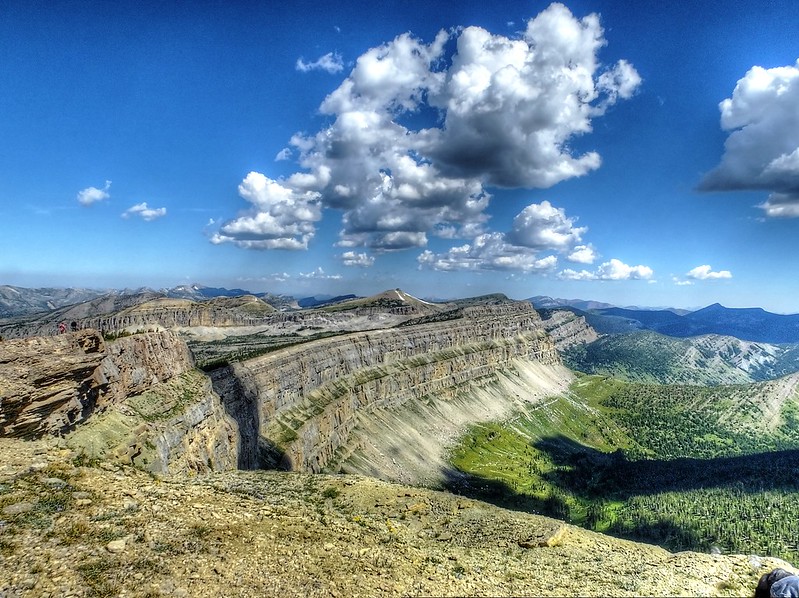What is the Chinese Wall of Montana?
The Chinese Wall is a limestone escarpment in Montana’s Bob Marshall Wilderness that stands at an impressive 1,300 ft (396 m) tall and runs a seemingly endless 22 miles (35 m) north-south along the Continental Divide.
The wall has a wave-like shape with a gentle slope down its west side and a vertical limestone wall on its east, forming the boundary between Flathead and Lewis & Clark Counties. Its highest elevation lies at Cliff Mountain (8,576 ft / 2,614 m).
Due to its remote location, few people visit Montana’s Chinese Wall. Unmistakable in its beauty and grandeur, the Chinese Wall of Montana makes for an unforgettable sight for anyone willing to make the 21-mile into Montana’s wilderness.
Read on for a guide to visiting Montana’s Chinese Wall. Plus, find out how this natural wonder was formed.
Montana’s Chinese Wall – How to get there, camping near the wall, and how the wall formed
Table of contents:
- How to visit Montana’s Chinese Wall
- Camping at Montana’s Chinese Wall
- Quick facts about Montana’s Chinese Wall
- Is Montana’s Chinese Wall worth seeing?
- How did Montana’s Chinese Wall form?
How to visit the Chinese Wall of Montana
The Chinese Wall of Montana lies inside the beautiful Bob Marshall Wilderness, tucked away in one of the many valleys lining the Lewis Range between Flathead Lake and the prairie of Montana’s northern Great Plains.

To see Montana’s Chinese Wall, you must hike 21 miles into the wilderness. The entire Chinese Valley Loop trail is 63 miles (101 km) long and takes roughly 6 days to hike.
Hiking to Montana’s Chinese Wall – The Chinese Wall Loop
Be bear aware: Always carry bear bells and bear spray when hiking in the Bob Marshall Wilderness. It’s highly likely you’ll encounter a bear or other wild animal on your hike or see fresh tracks along the way.
The Chinese Wall Loop starts from the Benchmark Trailhead, which you can reach by car via Benchmark Road from Augusta, Montana. The loop is best suited for experienced backpackers. Bring plenty of food, water, and proper clothing.
The west side of the loop uses part of the Continental Divide Trail (CDT). If you travel the loop clockwise, you’ll travel the CDT, first reaching the wall at Cliff Mountain Pass 21 miles (34 km) into the hike, or 8 hours into your journey.
The total elevation rise from Benchmark Trailhead to Cliff Mountain Pass is roughly 3,000 ft (914 m). From here, the CDT runs north along the bottom of the wall for roughly six miles (10 km), offering spectacular views of the towering wall and across the forest floor below.

Continue north past the wall. A few miles past the wall you’ll pass little My Lake, after which the trail turns east and descends into the Rock Creek Corridor.
About three-quarters of the way through the wooded corridor, the CDT trail turns left and continues north. Where the CDT turns north, you’ll continue east towards the North Fork of the Sun River. Near the North Fork of the Sun River, you turn south and continue back to the trailhead.
Once you leave the CDT, the trail disappears and splits apart in many places. Don’t hike the Chinese Wall Loop without first discussing the route with an experienced backpacker who has hiked the route before and always bring a detailed map and GPS system with you.
Get a detailed trail map of the Chinese Wall Loop
See a detailed online trail map of the Chinese Wall Loop via the Rock Creek Corridor route at CalTopo.
How long does it take to hike the Chinese Wall Loop?
It can take up to six days to hike the roughly 63 miles of the Chinese Wall Loop via the Rock Creek Corridor. However, experienced backpackers can do it in less.

The journey from the Benchmark Trailhead to Cliff Mountain Pass is about 21 miles (34 km). From here, it’s about 9 miles to My Lake, which lies just north of the wall.
Then, it’s 33 miles (53 km) down the Rock Creek Corridor to the North Fork of the Sun River and back to the trailhead.
Camping at Montana’s Chinese Wall
Multiple camp spots lie along the Chinese Loop Trail. In the valleys and prairies on the east side of the loop, many of the camps are horse camps, offering spacious areas to comfortably tent camp.
For camping close to the wall, there is a nice spot at Cliff Mountain Pass. However, be sure you remain outside the no-camping zone.
No-camping zone
To protect the local ecology around the wall, a no-camping zone lies along a central section of the wall, from Cliff Mountain to Salt Mountain. Be sure to camp outside of the no-camping zone.
Be bear aware
The Bob Marshall Wilderness is bear country. Remember to carry bear spray and bear bells and hang your food items from a tree or cliff far from camp.
Quick facts about Montana’s Chinese Wall

- Location: Bob Marshall Wilderness in the Lewis Range (between Flathead Lake and Augusta, Montana)
- Height: 1,300 ft / 396 m
- Length: 22 miles / 35 km
- Nearest town: Augusta (pop. 238)
- Composition: Limestone
Is Montana’s Chinese Wall worth seeing?
The Chinese Wall is a 1,300-foot tall limestone spine jutting from the wild landscape of the Bob Marshall Wilderness in western Montana. Its incredible length and height make it an impressive sight that is definitely worth seeing if you are up for the 21-mile (34-km) hike.
How did the Chinese Wall of Montana form?
Montana’s Chinese Wall is comprised of multiple layers of Middle Cambrian sedimentary rock, primarily limestone, that was deposited in the shallow seas that once covered this region of Montana 500 million years ago.

Between 600 and 100 million years ago, these sediments fell under great stress as tectonic plates shifted, folding and breaking layers of the earth’s crust. They elevated into formations of the Rocky Mountains, leaving behind unique structures like the Chinese Wall.
However, the sheer vertical east face of the wall owes its development to the glaciers that cut through this region roughly 50,000 years ago during the Pleistocene Era.
As the glaciers slowly rasped their way downward to lower elevations, they carved and shaped the Rocky Mountains into their rugged, present-day beauty, leaving behind magnificent features like the Chinese Wall as we see them today.

